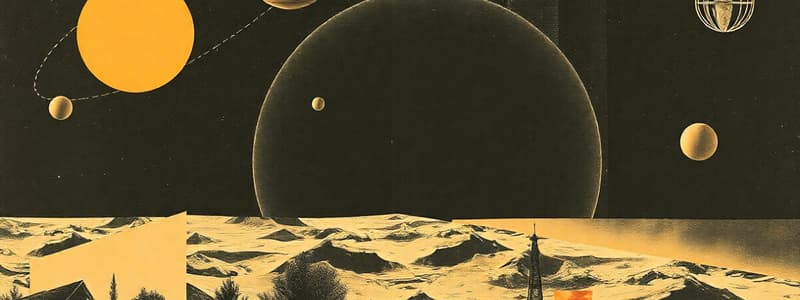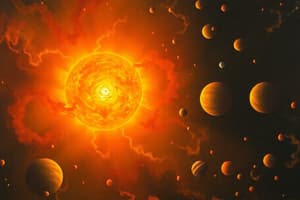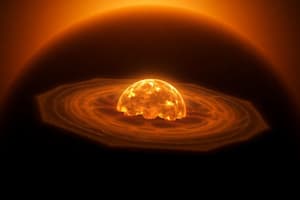Podcast
Questions and Answers
What key characteristic defines index fossils, aiding in the identification of geological time periods?
What key characteristic defines index fossils, aiding in the identification of geological time periods?
- Their presence in igneous rock layers.
- Their widespread distribution and indication of specific time in Earth's history. (correct)
- Their limited presence in only a few distinct geographical locations.
- Their sporadic distribution across different rock types.
How might scientists use trace fossils to understand the behavior of extinct animals?
How might scientists use trace fossils to understand the behavior of extinct animals?
- By comparing the size and shape of fossilized bones to living relatives.
- By examining fossilized stomach contents to infer diet.
- By analyzing the chemical composition of the fossilized remains.
- By studying fossilized footprints to infer speed and social behavior. (correct)
What role does genetic variation play in the long-term survival of a species when environmental conditions change?
What role does genetic variation play in the long-term survival of a species when environmental conditions change?
- Decreased genetic variation ensures all individuals are equally adapted, preventing rapid extinction.
- Increased genetic variation raises the likelihood that some individuals will possess traits suited to the new conditions. (correct)
- Genetic variation has no impact on species survival during environmental upheaval.
- Stable genetic variation guarantees the consistency of traits for predictable adaptation.
What is the significance of homologous structures in different species, such as the similar bone arrangement in the limbs of various mammals?
What is the significance of homologous structures in different species, such as the similar bone arrangement in the limbs of various mammals?
How do scientists utilize DNA to infer evolutionary relationships among species?
How do scientists utilize DNA to infer evolutionary relationships among species?
Why is the study of evolution in viruses, such as the influenza virus, particularly relevant to human health?
Why is the study of evolution in viruses, such as the influenza virus, particularly relevant to human health?
How does the fossil record provide evidence for the evolution of life on Earth, and what are its limitations?
How does the fossil record provide evidence for the evolution of life on Earth, and what are its limitations?
What is the most likely cause of adaptive radiation, as evidenced in the fossil record?
What is the most likely cause of adaptive radiation, as evidenced in the fossil record?
How did the industrial revolution influence the coloration of the peppered moth population in Britain?
How did the industrial revolution influence the coloration of the peppered moth population in Britain?
How does the concept of 'survival of the fittest' relate to natural selection?
How does the concept of 'survival of the fittest' relate to natural selection?
Why did the Grants spend nearly thirty years studying Darwin's finches on Daphne Major?
Why did the Grants spend nearly thirty years studying Darwin's finches on Daphne Major?
What role do mutations play in the process of natural selection and evolution?
What role do mutations play in the process of natural selection and evolution?
How do new species most commonly arise, as illustrated by the example of the guppies in a lake drying out to form two ponds?
How do new species most commonly arise, as illustrated by the example of the guppies in a lake drying out to form two ponds?
How does the Earth's atmosphere contribute to the planet's ability to support life?
How does the Earth's atmosphere contribute to the planet's ability to support life?
How are sedimentary rocks related to the formation and preservation of fossils?
How are sedimentary rocks related to the formation and preservation of fossils?
What role did volcanic activity play in the formation of Earth's early atmosphere?
What role did volcanic activity play in the formation of Earth's early atmosphere?
According to the nebular hypothesis, what triggered the initial collapse of the solar nebula that eventually formed our solar system?
According to the nebular hypothesis, what triggered the initial collapse of the solar nebula that eventually formed our solar system?
What are the key components of Earth's atmosphere?
What are the key components of Earth's atmosphere?
What is 'accretion' in the context of planet formation?
What is 'accretion' in the context of planet formation?
What evidence have scientists found that suggests life may have originated near a hydrothermal vent?
What evidence have scientists found that suggests life may have originated near a hydrothermal vent?
How do scientists use 'relative dating' to determine the age of rocks and fossils?
How do scientists use 'relative dating' to determine the age of rocks and fossils?
Why is the fossil record not a complete 'book' of past life on Earth?
Why is the fossil record not a complete 'book' of past life on Earth?
Besides remains of bodies, what else can fossils tell us about organisms?
Besides remains of bodies, what else can fossils tell us about organisms?
Why it is good to have an area in space that is considered a habitable zone?
Why it is good to have an area in space that is considered a habitable zone?
What are some observations Darwin based his hypothesis on?
What are some observations Darwin based his hypothesis on?
Flashcards
Nebular Hypothesis
Nebular Hypothesis
The hypothesis that the solar system formed from a giant rotating cloud of gas and dust.
Accretion
Accretion
The process by which small rocks came together to form planetesimals, which then collided to form planets.
Habitable Zone
Habitable Zone
The distance from a star where liquid water can exist on a planet's surface.
Atmosphere
Atmosphere
Signup and view all the flashcards
Gravity
Gravity
Signup and view all the flashcards
Magnetic Field
Magnetic Field
Signup and view all the flashcards
Water Cycle
Water Cycle
Signup and view all the flashcards
Fossils
Fossils
Signup and view all the flashcards
Body Fossils
Body Fossils
Signup and view all the flashcards
Trace Fossils
Trace Fossils
Signup and view all the flashcards
Relative Dating
Relative Dating
Signup and view all the flashcards
Absolute Dating
Absolute Dating
Signup and view all the flashcards
Mass Extinction
Mass Extinction
Signup and view all the flashcards
Adaptive Radiation
Adaptive Radiation
Signup and view all the flashcards
Population
Population
Signup and view all the flashcards
Natural Selection
Natural Selection
Signup and view all the flashcards
Alleles
Alleles
Signup and view all the flashcards
Genetic Variation
Genetic Variation
Signup and view all the flashcards
Mutation
Mutation
Signup and view all the flashcards
Evolution
Evolution
Signup and view all the flashcards
New Species
New Species
Signup and view all the flashcards
The Flu
The Flu
Signup and view all the flashcards
Scientific theory
Scientific theory
Signup and view all the flashcards
Homologous Structures
Homologous Structures
Signup and view all the flashcards
Blastula
Blastula
Signup and view all the flashcards
Study Notes
Earth's Formation and Early Conditions
- Earth formed approximately 4.6 billion years ago, as part of the solar system
- Solar system formation occurred via the nebular hypothesis
- According to this hypothesis, a solar nebula, a giant rotating cloud of gas and dust, gave rise to the solar system
- An unknown event, like a supernova shockwave, triggered the cloud's collapse under gravity
- The collapsing gas cloud formed a flat, rotating disk
- The center's increasing gravitational pull drew in more material
- Around 99.8% of the material formed a giant gas and dust ball at the disk's center
- Accumulating matter caused intense pressure and heat, leading to hydrogen fusion and helium creation
- This process birthed the sun
Planet Formation
- Material remained after the sun's formation and continued to revolve around it
- Gravity caused this material to coalesce, with small rocks forming larger ones
- These rocks formed planetesimals, which collided to create planets
- Smaller clumps of material became dwarf planets, moons, asteroids, and comets through accretion
- Collisions led some dwarf planets to grow into the solar system's eight planets, including Earth
Early Earth
- Discovering early Earth's exact conditions poses a challenge for scientists
- Early Earth was likely molten, then very hot with many volcanoes
- Asteroid collisions frequently cratered and heated the surface
- Volcanoes emitted lava and gases, contributing to the formation of a new atmosphere
- Cooling led to the formation of a solid rock surface, offering clues to early Earth's nature
Earth's Uniqueness and Conditions for Life
- Earths position, size, and composition have influenced the formation and evolution of life
- Earth is unique as the only known planet to support life, partially due to its distance from the sun
- Objects too close receive too much solar energy, while those too far receive too little
- The habitable zone is the optimal distance for life to thrive
Atmosphere and Liquid Water
- An atmosphere and its distance from the sun help maintain an average surface air temperature of 15°C
- The atmosphere comprises of nitrogen, oxygen, carbon dioxide, and water vapor
- It retains heavier gases due to its mass and gravitational force, but lighter gases escape
- A protective ozone layer shields life from harmful ultraviolet radiation
- A magnetic field protects the atmosphere from solar winds
- Convective motion of liquid metal in the outer core generates the magnetic field, sustaining life
Significance of Water
- Water is essential for life as water can exist in solid, liquid, and gas states due to Earth's moderate temperatures
- Oceans consist of liquid water, while the atmosphere contains water vapor
- Earth's weather occurs in the atmosphere, facilitating the movement of water and air
- The water cycle involves all forms of water
Origin and Evidence of Life
- Life on Earth originated around 3.5 billion years ago
- Microfossils, and stromatolites provide early evidence of life
- Some scientists propose life began near seafloor hydrothermal vents
- DNA is used by all life to pass on information from one generation to the next
- All life is related and scientists have traced the most likely common ancestor of all life to a microbe
Fossils
- Fossils preserve evidence of once-living organisms
- Body fossils include shells, bones, and teeth
- Trace fossils come from organism activities and include feces, footprints, or burrows
- Fossils are found in sedimentary rocks and exist from microscopic bacteria to giant trees and dinosaurs
Fossil Formation and Types
- Rapid sediment settlement creates ideal fossil formation and preservation conditions as rapid burial protects from decay and scavengers
- Fossilization happens in various ways
- Organisms can be preserved in ice, amber, or tar
- Molds create detailed imprints in rock
- Casts form when minerals fill molds
- Carbonized fossils leave a thin carbon film
- Replacement fossils involve mineral replacement of original material
Limitations and Interpretation of the Fossil Record
- Fossils cannot provide a complete record of an organism's appearance as fossilization is rare and incomplete
- Hard parts are more commonly preserved
- The fossil record aids scientists to interpret life on Earth, despite missing pieces
- Rock layers and fossil order help determine relative ages
- Relative dating compares fossil ages
- Absolute dating uses radioactive elements to estimate rock age ranges and works best on igneous rocks
Dating Methods
- Combining absolute dating and fossil types help create a geological time scale
- Index fossils identify rock age
- Fossil age and organism order provide information on inter-species relationships
- All life originated from one event and organisms can be related
- Relating relative ages helps build family relationship
Patterns in the Fossil Record
- Species occupy specific time intervals
- Fossil species differ from modern species
- Species appear, diversify, and disappear
- Extinction occurs, with only a fraction of past species existing today
- Extinction can be caused by competition or environmental changes
Mass Extinctions and Adaptive Radiation
- The fossil record reveals patterns of mass extinctions
- Mass extinctions are linked to asteroid impacts, volcanic eruptions, methane releases, and climate change
- The largest mass extinction wiped out 96% of species 250 million years ago
- An asteroid impact caused the extinction 66-65 million years ago that wiped out the dinosaurs
- Adaptive radiation is the rise in species diversification after a mass extinction
- Adaptive radiation happens when a trait allows survival in a habitat or enables competition
Evolutionary Trees and Transitional Forms
- New fossil species show evolution over time
- Fossil species characteristics help build family trees
- Nodes signify common ancestors
- Evolutionary trees help predict common ancestor existence
- Scientists use fossil and rock age to search for transitional forms, combining fossil data with other information to generate evolutionary trees
Contrasting Ancient and Modern Organisms
- Examining current organisms and fossil records reveals trends
- Fossils similar to modern species are discovered
- More recent fossils closely resemble extant forms
- Arthropods from millions of years ago had features in common with modern ones
- Fossil organisms in similar ecological role occupy similar ecological niches
Fossil Behavior and Diet
- Fossils provide data on extinct organism structure
- Fossil structures can be compared with modern organisms to infer aspects of their behavior
- Analysis of animal teeth reveals microscopic wear
- The "Lucy" fossil shows tough grasses and leaves were her diet
- Fossilized stomach contents shed insight on diet
- Analysis of fossilized feces reveal ecosystem feeding relationships
Interpreting Ancient Ecosystems
- Understanding ancient ecosystems involves studying fossils together, which helps scientists interpret groups of fossils related to warm saltwater seas
- Analysis of fossils and species distribution helps infer climate changes
- Fossils from the same organism reveal ancient continent positions
Trace Fossils and Animal Behavior
- Trace fossils, reveal information on stride length and shape of the prints of organisms
- Tracking reveals speed
- Groups of tracks may indicate social behavior, size, as well as the adults and young
- Burrow nests reveal behavior
- Crocodiles provide insight into egg burial
Galapagos Finches and Evolution
- Scientists study the relationship between environment and bird populations on a remote island to create a natural laboratory for studying changes
- Galapagos finches were studied, where scientists discovered that beaks size varied
- Beak size depended on diet
- Drought increased ground finches beak size
- Average finches beaks increase by 4%
- The birds are examples of natural selection
Species Diversity and Extinction
- The estimates of species on Earth range between 8 and 15 million
- Species have become extinct throughout Earth's history
- Fossil evidence points to modern species derived from extinct forms
Darwin and Natural Selection
- Charles Darwin's voyage on the HMS Beagle led him to collect fossils and specimens, which led to questions about species origins and distribution
- Darwin's "On the Origin of Species" introduced the hypothesis of evolution by natural selection
- The book explains where different species came from
- The hypothesis is supported by observed living creatures
Key Observations and Darwin's Conclusions
- All species can produce more offspring than needed
- Environmental conditions affects survival
- Individuals vary
- Darwin's conclusion notes that adapted organisms increase in numbers
Populations and Alleles
- Populations of species interbreed
- Variation is the raw material for natural selection
- Successful traits provide a survival advantage
- Genes determine traits
- Alleles effect how common a characteristic is
Genetic Variation and Adaptation
- A population with high genetic variation is more stable
- Adaptable individual are more likely to reproduce
- Lack of variation causes a population to decline and become extinct
Natural Selection
- Natural selection constantly tweaks traits
- New alleles can introduce new changes or be derived from another population
- DNA encodes information
- Genes determine characteristics
- Reproduction and chromosome contribute to hereditary information
Genes and Proteins
- Alleles control protein production
- Proteins are made of amino acids
- Different genes are caused by mutations
- A mutation is a change in the DNA of a gene
DNA Mutations
- DNA mutations can insert/delete/substitute nitrogen bases
- 3 nitrogen bases are read to indicate amino acids (called a codon)
- Populations interbreed and unique alleles come from new mutations
- Immigrations into a population brings new alleles and genes
- Natural selection determines the persist/disappearance of alleles
How Traits are Determined
- In mutations are harmful reproduction decreases and the mutated traits disappear
- If mutations are beneficial reproduction increases and the mutated traits persist
- Natural selection increases the commonality if desired traits and decreases the commonality of harmful traits
- Evolution depends on what traits survive and reproduce
Species Development
- Species develop due to environmental isolation or pressure to change
- One isolated population develops mutations
- Environmental conditions diverge them
Flu Virus Mutation (Example of Natural Selection)
- Flu causes outbreaks that are tracked
- Flu affects a quarter million Americans a year
- Flu causes death
- Flu vaccines help prevent the effects
- The mutations that result in a new disease strain is natural selection
Evidences of Evolution
- Evolution is a scientific theory backed up my measurements
- Scientific theories are comprehensive explanations and the theory of evolution explains how life changes over time
- Evolution is backed up by huge amounts of evidence, and they are continually refined
- Scientific theories can make predictions about the behavior of phenomena or even the existence of ones that have not been discovered
- Evolutionary theory can predict that the location and existence of fossils and living organisms before they have been discovered
Evolutionary Evidence
- The fossil record supports evolution
- Evolutionary occurs through natural selection
- Fossils record support the view that life has changed over long periods of time
- Most evidence comes from the fossil record, evolutionary trees, embryonic development, and DNA.
- Fossil records are incomplete due to location and the ability to create a fossil
- There are species in the past that remain unknown
Fossils
- Fossils help locate transitional fossils
- The horse tree came from fossil discoveries of extinct species
- In the last few decades, scientists have uncovered part of the mystery as to how whales, which are mammals, evolved as sea creatures
Body Structure and Development
- Homologous structures support evolution and appear in extinct organisms
- Embryos support evolution and appear during development
- Vertebrates are similar during development
- Organism developmental steps do see change over evolution
DNA and Evolution
- DNA traces ancestry and has proven genetic evolution
- By studying DNA, scientists discovered that flamingos are closely related to pigeons
- Similar functions are shared across different genotypes
- All animals form a hollow sphere of cells called a blastula
- Genes quickly generates different evolutionary properties
- Most evidence is inferred from evolution but it has been studied in real time
Pesticide Resistance
- Pesticides initially work
- Resistances develop
- Such resistance exists in DDT
- Resistance develops because resistant species breed and evolve
- Resistance develops in glyphosate
Virus & Bacteria Mutation
- Viruses and bacteria infect
- These replicated attacks come with mutations
- Mutated genes result in increased strength
- HIV resists drugs through quick evolution
- Antibiotics once killed bacteria
- New mutations causes resistance to antibiotic offspring
Australian Cane Toads
- Australian cane toads were introduced to control beetles
- The toads carried deadly predators
- The frogs spread faster and developed stronger legs
Pollution
- Pollution has caused evolutionary conditions due to change
- Evolution has occurred due to conditions
- The peppered moth in Britain is an example of evolution due to pollution
- Coal pollution blackened trees
- Certain mutations of the group had colored wings that aided birds
Studying That Suits You
Use AI to generate personalized quizzes and flashcards to suit your learning preferences.





